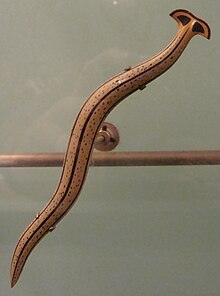Bipalium
| Bipalium | |
|---|---|
 |
|
| Model of Bipalium strubelli Graff, 1899 | |
| Scientific classification | |
| Kingdom: | Animalia |
| Phylum: | Platyhelminthes |
| Class: | Rhabditophora |
| Order: | Tricladida |
| Suborder: | Continenticola |
| Family: | Geoplanidae |
| Subfamily: | Bipaliinae |
| Genus: |
Bipalium Stimpson, 1857 |
| Type species | |
|
Bipalium fuscatum Stimpson, 1857 |
|
| Synonyms | |
Bipalium is a genus of large predatory land planarians. They are often loosely called "hammerhead worms" or "broadhead planarians" because of the distinctive shape of their head region. Land planarians are unique in that they possess a "creeping sole" on their ventral side. Several species are considered as invasive to the United States and to Europe. Some studies have begun the investigation of the evolutionary ecology of these invasive planarians.
The genus Bipalium was initially defined by Stimpson to include land planarians with the head broadened, forming a head plate. Later, in 1899, Ludwig von Graff divided it into three genera according to the shape of the head shape:
Josef Müller, in 1902, considered that there was no sufficient anatomical basis for this distinction and reunited them under Bipalium. Later von Graff accepted Müller's conclusions.
Towards the end of the 20th century, Robert E. Ogren and Masaharu Kawakatsu started a series of publications called "The Land Planarian Index series" in which they reviewed and organized all taxonomic information regarding land planarians. At first they retained all broad-headed planarians in the genus Bipalium, but later split them into four genera based on the anatomy of the reproductive organs: Bipalium, Novibipalium, Humbertium and Diversibipalium.
Under this scenario, the genus Bipalium is defined as containing broad-headed land planarians with simple copulatory organs, without accessory ducts or copulatory bursa, and with a fold of tissue separating the male and female exit ducts.
The name Bipalium comes from Latin bi-, two + pala, shovel or spade, because species in this genus resemble a pickaxe.
The genus Bipalium currently includes the following species:
...
Wikipedia
